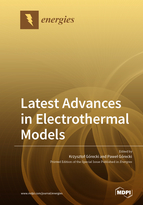Latest Advances in Electrothermal Models
A special issue of Energies (ISSN 1996-1073). This special issue belongs to the section "J: Thermal Management".
Deadline for manuscript submissions: closed (15 June 2020) | Viewed by 17057
Special Issue Editors
Interests: power electronics; power converters; wireless power transfer; energy storage technology; magnetic elements; modelling electronic components and systems; IGBT; MOSFET; BJT; power LEDs; electrothermal analysis
Special Issues, Collections and Topics in MDPI journals
Interests: power electronics; dc-dc converters; thermal phenomena; modelling; electrothermal modelling; self-heating; thermal impedance; averaged modelling
Special Issues, Collections and Topics in MDPI journals
Special Issue Information
Dear Colleagues,
For many years, tendencies to miniaturize electronic circuits and to increase power density dissipated in these circuits have been observed. During operation of electronic components, their internal temperature increases due to self-heating phenomena and mutual thermal couplings between components located on the common base. An increase in the device’s internal temperature causes changes in characteristics of electronic components and also causes a decrease of the life time of these components.
Therefore, one of the biggest problems of the present electronics is accurate calculation values of internal temperature of such components. Solving this task requires accurate models of the considered components and circuits, which take into account all important physical phenomena occurring in these components and circuits. Models including both electrical and thermal phenomena are called electrothermal models. Such types of models have been described in literature for the last 50 years, but development of electronic technology also causes a development of electrothermal models of electronic components. New versions of such a class of models have different forms and are dedicated to different programs for a computer analysis of electronic circuits, and they could also make it possible to shorten the duration time of calculations. An effective electrothermal analysis also requires effective methods of estimation of parameter values existing in the used models.
In recent years, we can observe dynamic development of the abovementioned electrothermal models. This Special Issue of Energies is devoted to the latest advances in this area.
Prof. Dr. Krzysztof GóreckiDr. Paweł Górecki
Guest Editors
Manuscript Submission Information
Manuscripts should be submitted online at www.mdpi.com by registering and logging in to this website. Once you are registered, click here to go to the submission form. Manuscripts can be submitted until the deadline. All submissions that pass pre-check are peer-reviewed. Accepted papers will be published continuously in the journal (as soon as accepted) and will be listed together on the special issue website. Research articles, review articles as well as short communications are invited. For planned papers, a title and short abstract (about 100 words) can be sent to the Editorial Office for announcement on this website.
Submitted manuscripts should not have been published previously, nor be under consideration for publication elsewhere (except conference proceedings papers). All manuscripts are thoroughly refereed through a single-blind peer-review process. A guide for authors and other relevant information for submission of manuscripts is available on the Instructions for Authors page. Energies is an international peer-reviewed open access semimonthly journal published by MDPI.
Please visit the Instructions for Authors page before submitting a manuscript. The Article Processing Charge (APC) for publication in this open access journal is 2600 CHF (Swiss Francs). Submitted papers should be well formatted and use good English. Authors may use MDPI's English editing service prior to publication or during author revisions.
Keywords
- Modeling
- Compact electrothermal models
- 2D and 3D electrothermal models
- Thermal phenomena
- Self-heating
- Mutual thermal couplings
- Electronic components
- Computer simulations
- Cooling systems
- Parameter estimation







